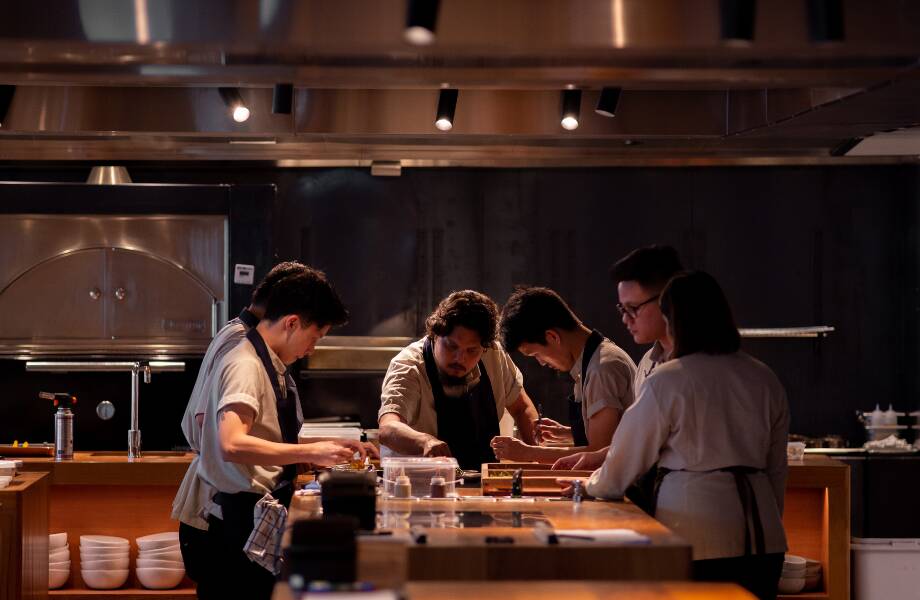Add Oil is a monthly series in which we digest trends and grill entrepreneurs from across the universe of Chinese food and drink. Drop us a line if you have a suggestion.
When Jamie Pea first visited Beijing in 2013, she was shocked by the diversity of vegetables available. She didn’t recognize many of them or know their proper names. Sometimes, neither did the vendors.
The unfamiliarity unnerved Pea but also sparked her creativity. She wanted to find out the names and stories behind these “China-only” specials. She began thinking, “How cool would it be if I could take these Chinese vegetables that have never been used in Western cooking and do something new with it,” she says.

A profile of Jamie Pea (photo from Jamie Pea)
Since then, Pea has been exploring and discovering local foods across the country, in preparation for compiling an illustrated encyclopedia of Chinese vegetables together with a collection of vegetarian recipes.
The idea behind the encyclopedia is to provide a common language for understanding China’s incredibly diverse array of vegetables. “I want to be Putonghua [Mandarin] for vegetables,” Pea says. “When you make it linguistically accessible, people will start cooking them more and appreciate the culture.”
Related:
 Kickstart This: Chinese Vegetables Trading CardsArticle Oct 19, 2018
Kickstart This: Chinese Vegetables Trading CardsArticle Oct 19, 2018
A Librarian of Chinese Vegetables
Born in Hong Kong and raised in New Jersey from the age of 7, Pea learned cooking skills through helping her mom in the kitchen. One of her favorite childhood memories was making vegetarian dumplings with her family that had wood ear fungus, carrots, translucent noodles, and Chinese chives in them.
That home cooking experience was halted when her parents moved back to Hong Kong and she went to a boarding school at 15. Instead, Pea honed her culinary skills at her friend’s place who lived next door to the school.
“I felt I’m actually pretty good at this, better than most people,” she says. “I really feel a lot of joy from feeding my friends.”
During a trip to visit her parents in Hong Kong over the summer break at college, Pea obtained an apprenticeship in the city at The Peninsula Hotel. The experience of working in the kitchen of a luxury hotel was an intense one she admits, but rather than put her off cooking, her stint working there made her “addicted to the whole process of turning ingredients into something beautiful.”
She’s since pursued this goal at institutions such as Nick’s Fine Foods London, Bo Innovation London, Egg Shanghai, and most recently two Michelin starred restaurant Tai’an Table Shanghai.
Now, Pea — who majored in English Literature — has decided to step out of the kitchen and write more about food.
“I want to make a bigger impact through education and sharing,” she says. “And also find out about ancient Chinese food traditions and techniques to help young chefs, maybe one day, to learn from the past so they can innovate for the future.”
That’s why Pea started her new job as a writer at Tai’an Table, while continuing to research Chinese vegetables on the side. She draws inspiration from looking back on the multi-layered histories of food:
“How did a soybean become tofu, fermented bean curd, and soy sauce? It’s because of that necessity of survival skills. By processing food every single day, you develop the skills over time and innovate and turn it into an art form.”
Sweet and Easy
Thanks to plant-based sauces such as doubanjiang, soy sauce, sesame oil, and fermented tofu, Chinese food is an easy (and delicious) way to go vegetarian. “These sauces enhance the flavor of vegetables and make food really taste exciting,” explains Pea.
“More people are interested in plant-based diets, or plant-based cooking at home, and Chinese cuisine is such a great way to start.”
The diversity of nutrients coming from different Chinese vegetables also amazes Pea. Even in meat dishes, she says, there are multiple veggies added, for example, tofu skin, carrots, and wood ear fungus are often seen in certain chicken dishes.
Pea’s own vegan diet has pushed her to discover even more types of vegetables, foods, and recipes that other people may have forgotten. “It’s so easily healthy and you get such a balanced diet from Chinese food,” she says.
Related:
 Tofu Isn’t “Bland.” It’s Just MisunderstoodIf you’ve ever had tofu in Chinese food, you’ll know that it’s anything but “bland”Article Aug 06, 2020
Tofu Isn’t “Bland.” It’s Just MisunderstoodIf you’ve ever had tofu in Chinese food, you’ll know that it’s anything but “bland”Article Aug 06, 2020
It’s this message that she hopes to share through her encyclopedia and through a series of events, such as a vegetarian food tour of Shanghai as part of SOCIAL SUPPLY’s FEAST 2021, an annual food festival held in the city.
“Other people can improve the diversity of their diet and creative skills if I can be the person who collects all of this knowledge out there to share with people,” she says.
Pea also plans to host a Chinese dessert stand at the festival. Chinese desserts such as red bean paste, shaved ice, and ice jelly are all vegan, she says, and utilize “plant-based materials in interesting ways.”
“What I think is more powerful about sharing vegan/vegetarian recipes in the world right now is that I want people to see how genius Chinese cuisine is. I would really love to get the message out there that Chinese desserts can be really amazing, fun, delicious, and also plant-based.”
Check back in with RADII later this month for our coverage of FEAST 2021.
Cover photo: courtesy of Jamie Pea
















